PNUR124: Medication Teaching Plan Template for Diabetes Mellitus
VerifiedAdded on 2022/09/12
|7
|1749
|51
Homework Assignment
AI Summary
This assignment presents a detailed medication teaching plan designed for a 60-year-old male patient, Mr. E, who has diabetes mellitus and is prescribed Trajenta. The plan utilizes the classical conditioning learning theory to improve the patient's understanding and adherence to medication. It outlines the teaching session's objectives, which are for the patient to explain the function and side effects of Trajenta. The content covers definitions of diabetes and Trajenta, drug uses, side effects, contraindications, administration, and the importance of adherence. Teaching strategies include face-to-face explanations, diagrams, and examples. The evaluation confirms Mr. E's understanding of the medication's purpose, side effects, and adherence importance, along with his commitment to taking medication regularly. The plan also references relevant academic sources to support the information provided.
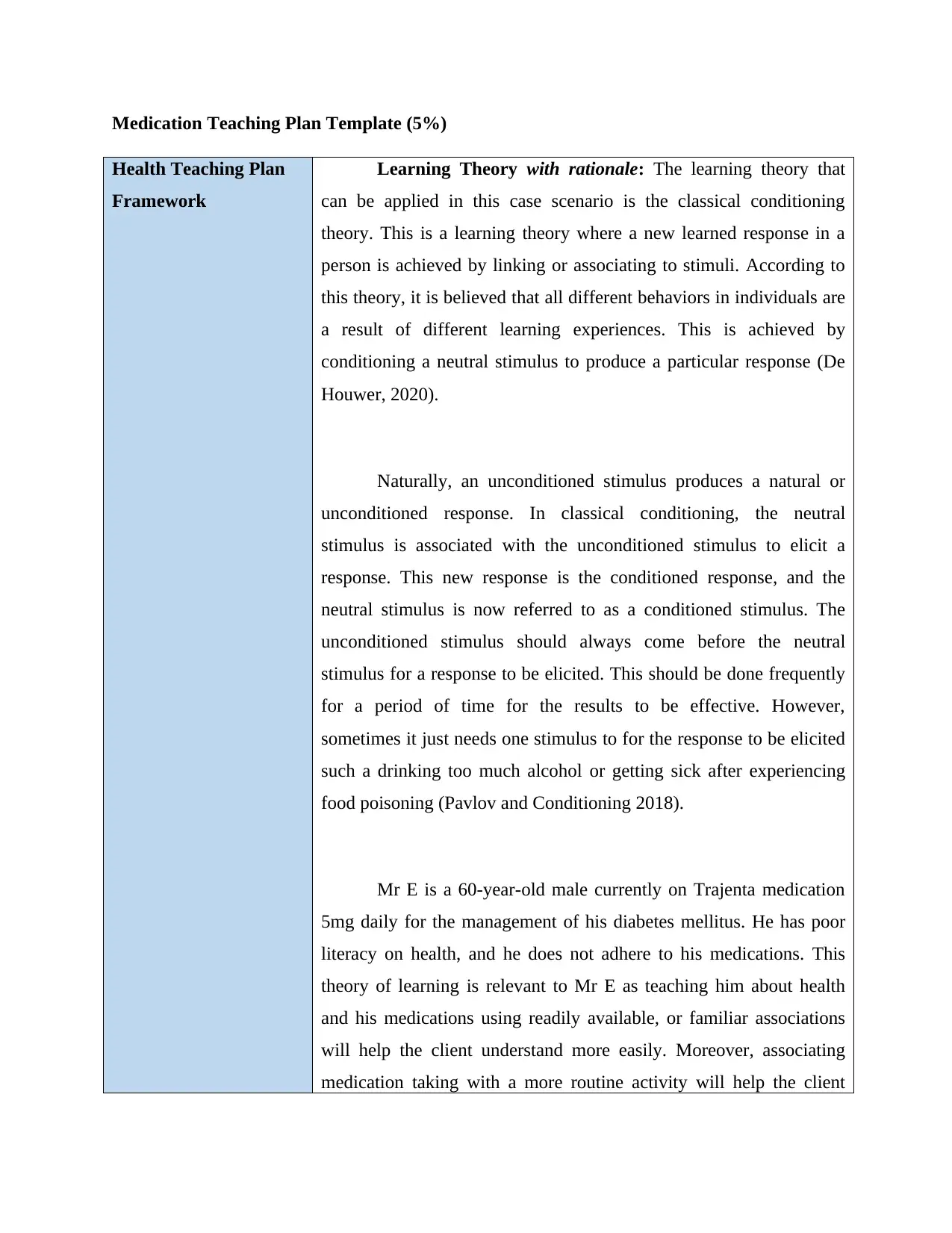
Medication Teaching Plan Template (5%)
Health Teaching Plan
Framework
Learning Theory with rationale: The learning theory that
can be applied in this case scenario is the classical conditioning
theory. This is a learning theory where a new learned response in a
person is achieved by linking or associating to stimuli. According to
this theory, it is believed that all different behaviors in individuals are
a result of different learning experiences. This is achieved by
conditioning a neutral stimulus to produce a particular response (De
Houwer, 2020).
Naturally, an unconditioned stimulus produces a natural or
unconditioned response. In classical conditioning, the neutral
stimulus is associated with the unconditioned stimulus to elicit a
response. This new response is the conditioned response, and the
neutral stimulus is now referred to as a conditioned stimulus. The
unconditioned stimulus should always come before the neutral
stimulus for a response to be elicited. This should be done frequently
for a period of time for the results to be effective. However,
sometimes it just needs one stimulus to for the response to be elicited
such a drinking too much alcohol or getting sick after experiencing
food poisoning (Pavlov and Conditioning 2018).
Mr E is a 60-year-old male currently on Trajenta medication
5mg daily for the management of his diabetes mellitus. He has poor
literacy on health, and he does not adhere to his medications. This
theory of learning is relevant to Mr E as teaching him about health
and his medications using readily available, or familiar associations
will help the client understand more easily. Moreover, associating
medication taking with a more routine activity will help the client
Health Teaching Plan
Framework
Learning Theory with rationale: The learning theory that
can be applied in this case scenario is the classical conditioning
theory. This is a learning theory where a new learned response in a
person is achieved by linking or associating to stimuli. According to
this theory, it is believed that all different behaviors in individuals are
a result of different learning experiences. This is achieved by
conditioning a neutral stimulus to produce a particular response (De
Houwer, 2020).
Naturally, an unconditioned stimulus produces a natural or
unconditioned response. In classical conditioning, the neutral
stimulus is associated with the unconditioned stimulus to elicit a
response. This new response is the conditioned response, and the
neutral stimulus is now referred to as a conditioned stimulus. The
unconditioned stimulus should always come before the neutral
stimulus for a response to be elicited. This should be done frequently
for a period of time for the results to be effective. However,
sometimes it just needs one stimulus to for the response to be elicited
such a drinking too much alcohol or getting sick after experiencing
food poisoning (Pavlov and Conditioning 2018).
Mr E is a 60-year-old male currently on Trajenta medication
5mg daily for the management of his diabetes mellitus. He has poor
literacy on health, and he does not adhere to his medications. This
theory of learning is relevant to Mr E as teaching him about health
and his medications using readily available, or familiar associations
will help the client understand more easily. Moreover, associating
medication taking with a more routine activity will help the client
Paraphrase This Document
Need a fresh take? Get an instant paraphrase of this document with our AI Paraphraser
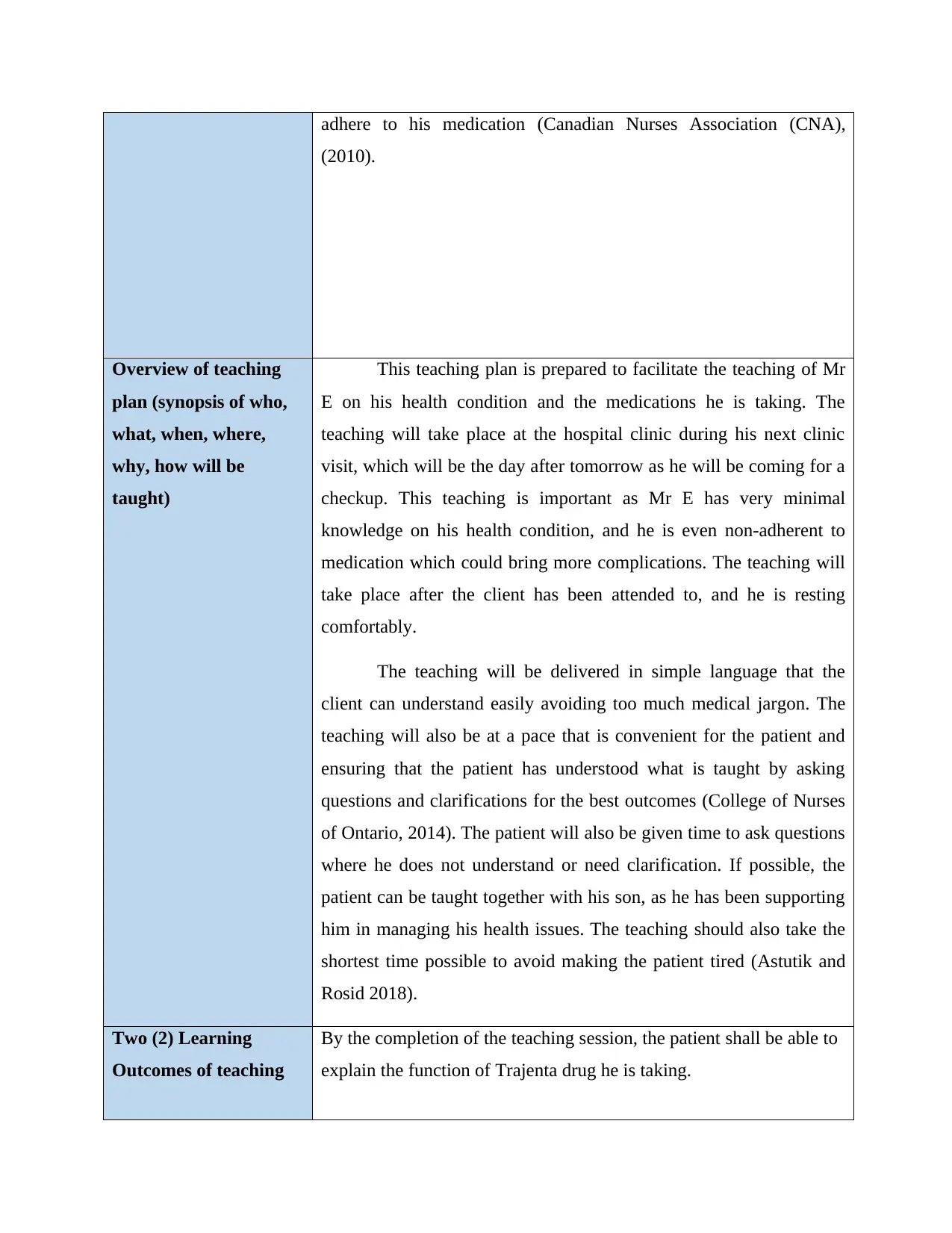
adhere to his medication (Canadian Nurses Association (CNA),
(2010).
Overview of teaching
plan (synopsis of who,
what, when, where,
why, how will be
taught)
This teaching plan is prepared to facilitate the teaching of Mr
E on his health condition and the medications he is taking. The
teaching will take place at the hospital clinic during his next clinic
visit, which will be the day after tomorrow as he will be coming for a
checkup. This teaching is important as Mr E has very minimal
knowledge on his health condition, and he is even non-adherent to
medication which could bring more complications. The teaching will
take place after the client has been attended to, and he is resting
comfortably.
The teaching will be delivered in simple language that the
client can understand easily avoiding too much medical jargon. The
teaching will also be at a pace that is convenient for the patient and
ensuring that the patient has understood what is taught by asking
questions and clarifications for the best outcomes (College of Nurses
of Ontario, 2014). The patient will also be given time to ask questions
where he does not understand or need clarification. If possible, the
patient can be taught together with his son, as he has been supporting
him in managing his health issues. The teaching should also take the
shortest time possible to avoid making the patient tired (Astutik and
Rosid 2018).
Two (2) Learning
Outcomes of teaching
By the completion of the teaching session, the patient shall be able to
explain the function of Trajenta drug he is taking.
(2010).
Overview of teaching
plan (synopsis of who,
what, when, where,
why, how will be
taught)
This teaching plan is prepared to facilitate the teaching of Mr
E on his health condition and the medications he is taking. The
teaching will take place at the hospital clinic during his next clinic
visit, which will be the day after tomorrow as he will be coming for a
checkup. This teaching is important as Mr E has very minimal
knowledge on his health condition, and he is even non-adherent to
medication which could bring more complications. The teaching will
take place after the client has been attended to, and he is resting
comfortably.
The teaching will be delivered in simple language that the
client can understand easily avoiding too much medical jargon. The
teaching will also be at a pace that is convenient for the patient and
ensuring that the patient has understood what is taught by asking
questions and clarifications for the best outcomes (College of Nurses
of Ontario, 2014). The patient will also be given time to ask questions
where he does not understand or need clarification. If possible, the
patient can be taught together with his son, as he has been supporting
him in managing his health issues. The teaching should also take the
shortest time possible to avoid making the patient tired (Astutik and
Rosid 2018).
Two (2) Learning
Outcomes of teaching
By the completion of the teaching session, the patient shall be able to
explain the function of Trajenta drug he is taking.
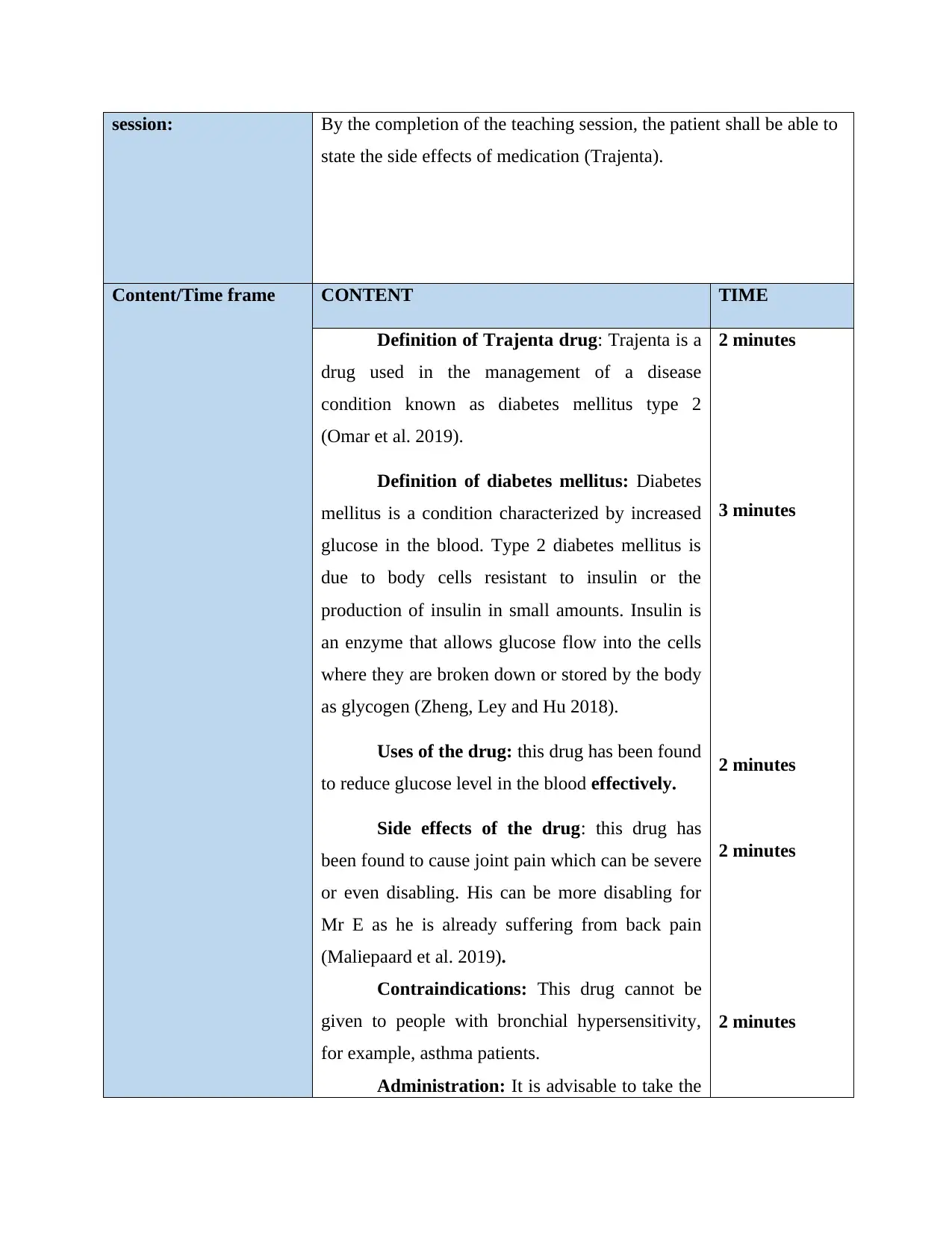
session: By the completion of the teaching session, the patient shall be able to
state the side effects of medication (Trajenta).
Content/Time frame CONTENT TIME
Definition of Trajenta drug: Trajenta is a
drug used in the management of a disease
condition known as diabetes mellitus type 2
(Omar et al. 2019).
Definition of diabetes mellitus: Diabetes
mellitus is a condition characterized by increased
glucose in the blood. Type 2 diabetes mellitus is
due to body cells resistant to insulin or the
production of insulin in small amounts. Insulin is
an enzyme that allows glucose flow into the cells
where they are broken down or stored by the body
as glycogen (Zheng, Ley and Hu 2018).
Uses of the drug: this drug has been found
to reduce glucose level in the blood effectively.
Side effects of the drug: this drug has
been found to cause joint pain which can be severe
or even disabling. His can be more disabling for
Mr E as he is already suffering from back pain
(Maliepaard et al. 2019).
Contraindications: This drug cannot be
given to people with bronchial hypersensitivity,
for example, asthma patients.
Administration: It is advisable to take the
2 minutes
3 minutes
2 minutes
2 minutes
2 minutes
state the side effects of medication (Trajenta).
Content/Time frame CONTENT TIME
Definition of Trajenta drug: Trajenta is a
drug used in the management of a disease
condition known as diabetes mellitus type 2
(Omar et al. 2019).
Definition of diabetes mellitus: Diabetes
mellitus is a condition characterized by increased
glucose in the blood. Type 2 diabetes mellitus is
due to body cells resistant to insulin or the
production of insulin in small amounts. Insulin is
an enzyme that allows glucose flow into the cells
where they are broken down or stored by the body
as glycogen (Zheng, Ley and Hu 2018).
Uses of the drug: this drug has been found
to reduce glucose level in the blood effectively.
Side effects of the drug: this drug has
been found to cause joint pain which can be severe
or even disabling. His can be more disabling for
Mr E as he is already suffering from back pain
(Maliepaard et al. 2019).
Contraindications: This drug cannot be
given to people with bronchial hypersensitivity,
for example, asthma patients.
Administration: It is advisable to take the
2 minutes
3 minutes
2 minutes
2 minutes
2 minutes
⊘ This is a preview!⊘
Do you want full access?
Subscribe today to unlock all pages.

Trusted by 1+ million students worldwide
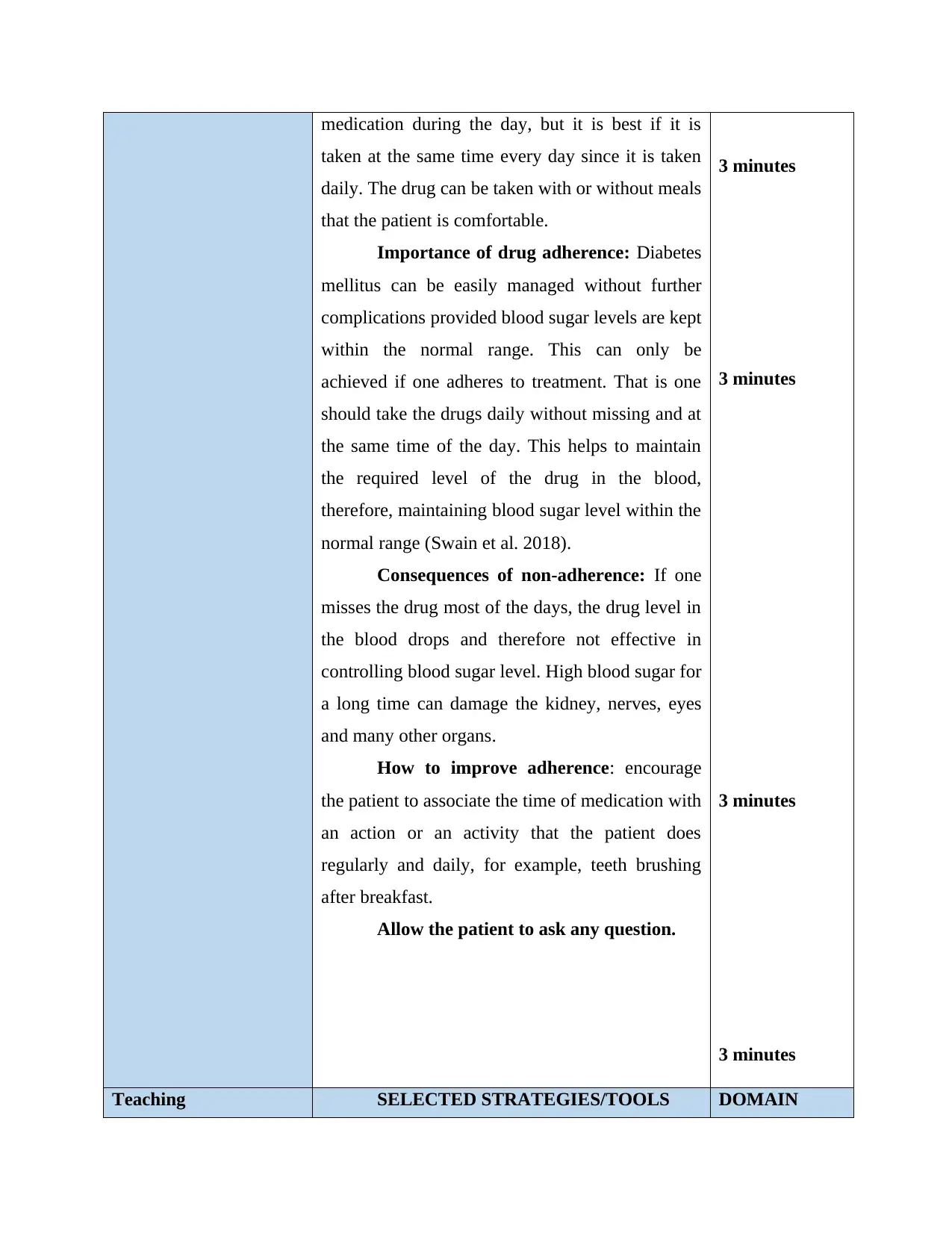
medication during the day, but it is best if it is
taken at the same time every day since it is taken
daily. The drug can be taken with or without meals
that the patient is comfortable.
Importance of drug adherence: Diabetes
mellitus can be easily managed without further
complications provided blood sugar levels are kept
within the normal range. This can only be
achieved if one adheres to treatment. That is one
should take the drugs daily without missing and at
the same time of the day. This helps to maintain
the required level of the drug in the blood,
therefore, maintaining blood sugar level within the
normal range (Swain et al. 2018).
Consequences of non-adherence: If one
misses the drug most of the days, the drug level in
the blood drops and therefore not effective in
controlling blood sugar level. High blood sugar for
a long time can damage the kidney, nerves, eyes
and many other organs.
How to improve adherence: encourage
the patient to associate the time of medication with
an action or an activity that the patient does
regularly and daily, for example, teeth brushing
after breakfast.
Allow the patient to ask any question.
3 minutes
3 minutes
3 minutes
3 minutes
Teaching SELECTED STRATEGIES/TOOLS DOMAIN
taken at the same time every day since it is taken
daily. The drug can be taken with or without meals
that the patient is comfortable.
Importance of drug adherence: Diabetes
mellitus can be easily managed without further
complications provided blood sugar levels are kept
within the normal range. This can only be
achieved if one adheres to treatment. That is one
should take the drugs daily without missing and at
the same time of the day. This helps to maintain
the required level of the drug in the blood,
therefore, maintaining blood sugar level within the
normal range (Swain et al. 2018).
Consequences of non-adherence: If one
misses the drug most of the days, the drug level in
the blood drops and therefore not effective in
controlling blood sugar level. High blood sugar for
a long time can damage the kidney, nerves, eyes
and many other organs.
How to improve adherence: encourage
the patient to associate the time of medication with
an action or an activity that the patient does
regularly and daily, for example, teeth brushing
after breakfast.
Allow the patient to ask any question.
3 minutes
3 minutes
3 minutes
3 minutes
Teaching SELECTED STRATEGIES/TOOLS DOMAIN
Paraphrase This Document
Need a fresh take? Get an instant paraphrase of this document with our AI Paraphraser
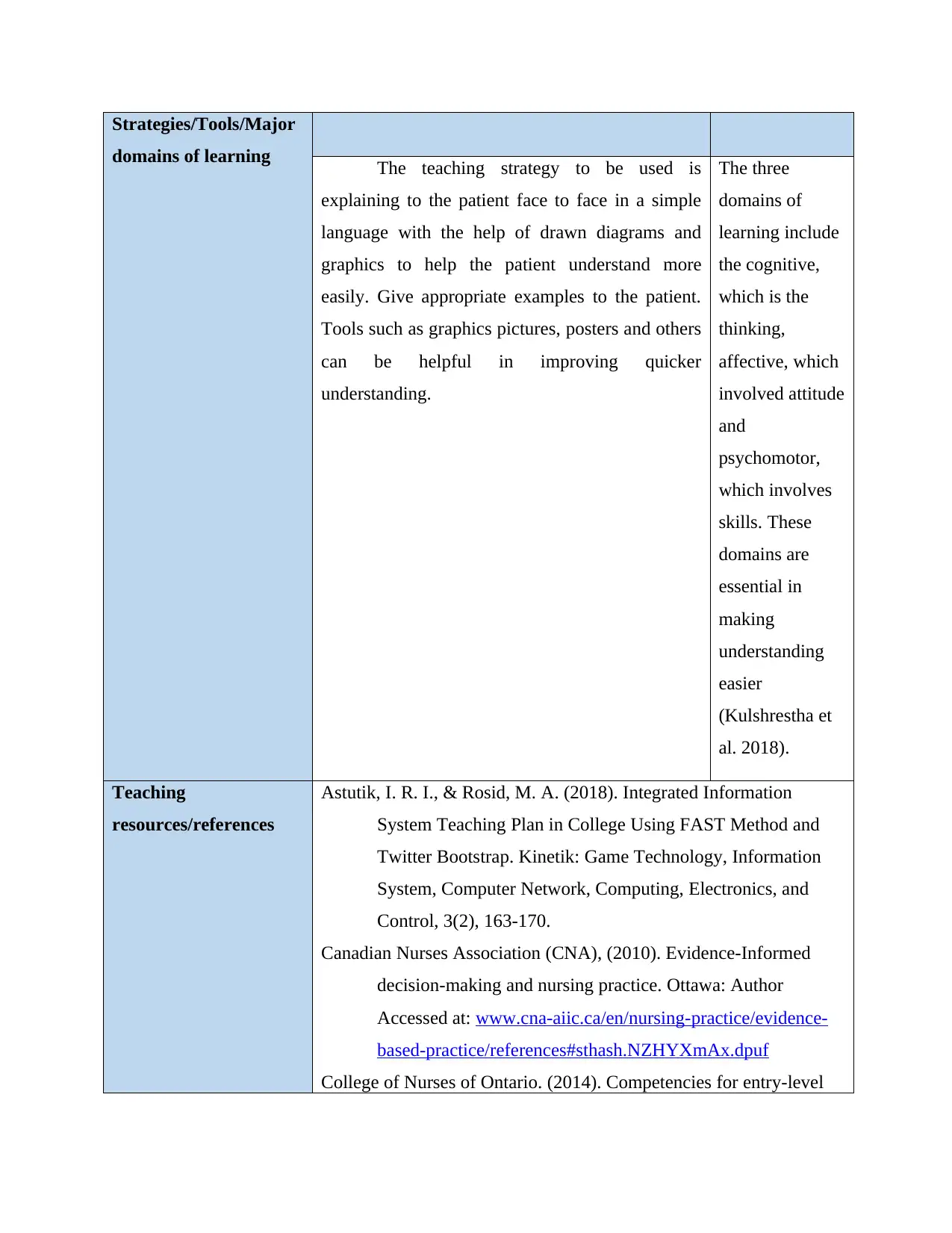
Strategies/Tools/Major
domains of learning The teaching strategy to be used is
explaining to the patient face to face in a simple
language with the help of drawn diagrams and
graphics to help the patient understand more
easily. Give appropriate examples to the patient.
Tools such as graphics pictures, posters and others
can be helpful in improving quicker
understanding.
The three
domains of
learning include
the cognitive,
which is the
thinking,
affective, which
involved attitude
and
psychomotor,
which involves
skills. These
domains are
essential in
making
understanding
easier
(Kulshrestha et
al. 2018).
Teaching
resources/references
Astutik, I. R. I., & Rosid, M. A. (2018). Integrated Information
System Teaching Plan in College Using FAST Method and
Twitter Bootstrap. Kinetik: Game Technology, Information
System, Computer Network, Computing, Electronics, and
Control, 3(2), 163-170.
Canadian Nurses Association (CNA), (2010). Evidence-Informed
decision-making and nursing practice. Ottawa: Author
Accessed at: www.cna-aiic.ca/en/nursing-practice/evidence-
based-practice/references#sthash.NZHYXmAx.dpuf
College of Nurses of Ontario. (2014). Competencies for entry-level
domains of learning The teaching strategy to be used is
explaining to the patient face to face in a simple
language with the help of drawn diagrams and
graphics to help the patient understand more
easily. Give appropriate examples to the patient.
Tools such as graphics pictures, posters and others
can be helpful in improving quicker
understanding.
The three
domains of
learning include
the cognitive,
which is the
thinking,
affective, which
involved attitude
and
psychomotor,
which involves
skills. These
domains are
essential in
making
understanding
easier
(Kulshrestha et
al. 2018).
Teaching
resources/references
Astutik, I. R. I., & Rosid, M. A. (2018). Integrated Information
System Teaching Plan in College Using FAST Method and
Twitter Bootstrap. Kinetik: Game Technology, Information
System, Computer Network, Computing, Electronics, and
Control, 3(2), 163-170.
Canadian Nurses Association (CNA), (2010). Evidence-Informed
decision-making and nursing practice. Ottawa: Author
Accessed at: www.cna-aiic.ca/en/nursing-practice/evidence-
based-practice/references#sthash.NZHYXmAx.dpuf
College of Nurses of Ontario. (2014). Competencies for entry-level

Registered Nurse practice. Retrieved from:
www.cno.org/Global/docs/reg/41037_EntryToPracitic
De Houwer, J. (2020). Revisiting classical conditioning as a model
for anxiety disorders: A conceptual analysis and brief review.
Behaviour Research and Therapy, 127, 103558.
Kulshrestha, S. P., Sharma, P. C., Jamini, N., Singh, V. P., Bala, K.,
Singh, L. C., ... & Kumar, S. (2018). Unit-11 Domains of
Learning. IGNOU.
Maliepaard, M., Taams, A. C., Sung, C., Poh, J., & Yu, Y. (2019).
Ethnicity-Specific Drug Safety Data in European Medicines
Agency Registration Dossiers, European Public Assessment
Reports, and European and
Omar, M. A., Haredy, A. M., Saleh, G. A., Naggar, A. H., & Derayea,
S. M. (2019). Diarylpyrrolone based fluorophore for the
selective spectrofluorometric method for determination of
Linagliptin antidiabetic drug in pharmaceutical tablets.
Microchemical Journal, 148, 555-560.
Pavlov, I., & Conditioning, C. (2018). Theory, Experiments &
Contributions to Psychology.
Singapore Drug Labels: Lost in Translation?. Pharmaceutical
Medicine, 33(5), 407-416.
Swain, S. P., Samal, S., Sahu, K. S., & Rout, S. K. (2018). Out-of-
pocket expenditure and drug adherence of patients with
diabetes in Odisha. Journal of family medicine and primary
care, 7(6), 1229.
Zheng, Y., Ley, S. H., & Hu, F. B. (2018). Global aetiology and
epidemiology of type 2 diabetes mellitus and its
complications. Nature Reviews Endocrinology, 14(2), 88.
Evaluation By the end of the teaching session, Mr E was able to explain
what the Trajenta drug was and its use. He states that it was a drug
www.cno.org/Global/docs/reg/41037_EntryToPracitic
De Houwer, J. (2020). Revisiting classical conditioning as a model
for anxiety disorders: A conceptual analysis and brief review.
Behaviour Research and Therapy, 127, 103558.
Kulshrestha, S. P., Sharma, P. C., Jamini, N., Singh, V. P., Bala, K.,
Singh, L. C., ... & Kumar, S. (2018). Unit-11 Domains of
Learning. IGNOU.
Maliepaard, M., Taams, A. C., Sung, C., Poh, J., & Yu, Y. (2019).
Ethnicity-Specific Drug Safety Data in European Medicines
Agency Registration Dossiers, European Public Assessment
Reports, and European and
Omar, M. A., Haredy, A. M., Saleh, G. A., Naggar, A. H., & Derayea,
S. M. (2019). Diarylpyrrolone based fluorophore for the
selective spectrofluorometric method for determination of
Linagliptin antidiabetic drug in pharmaceutical tablets.
Microchemical Journal, 148, 555-560.
Pavlov, I., & Conditioning, C. (2018). Theory, Experiments &
Contributions to Psychology.
Singapore Drug Labels: Lost in Translation?. Pharmaceutical
Medicine, 33(5), 407-416.
Swain, S. P., Samal, S., Sahu, K. S., & Rout, S. K. (2018). Out-of-
pocket expenditure and drug adherence of patients with
diabetes in Odisha. Journal of family medicine and primary
care, 7(6), 1229.
Zheng, Y., Ley, S. H., & Hu, F. B. (2018). Global aetiology and
epidemiology of type 2 diabetes mellitus and its
complications. Nature Reviews Endocrinology, 14(2), 88.
Evaluation By the end of the teaching session, Mr E was able to explain
what the Trajenta drug was and its use. He states that it was a drug
⊘ This is a preview!⊘
Do you want full access?
Subscribe today to unlock all pages.

Trusted by 1+ million students worldwide
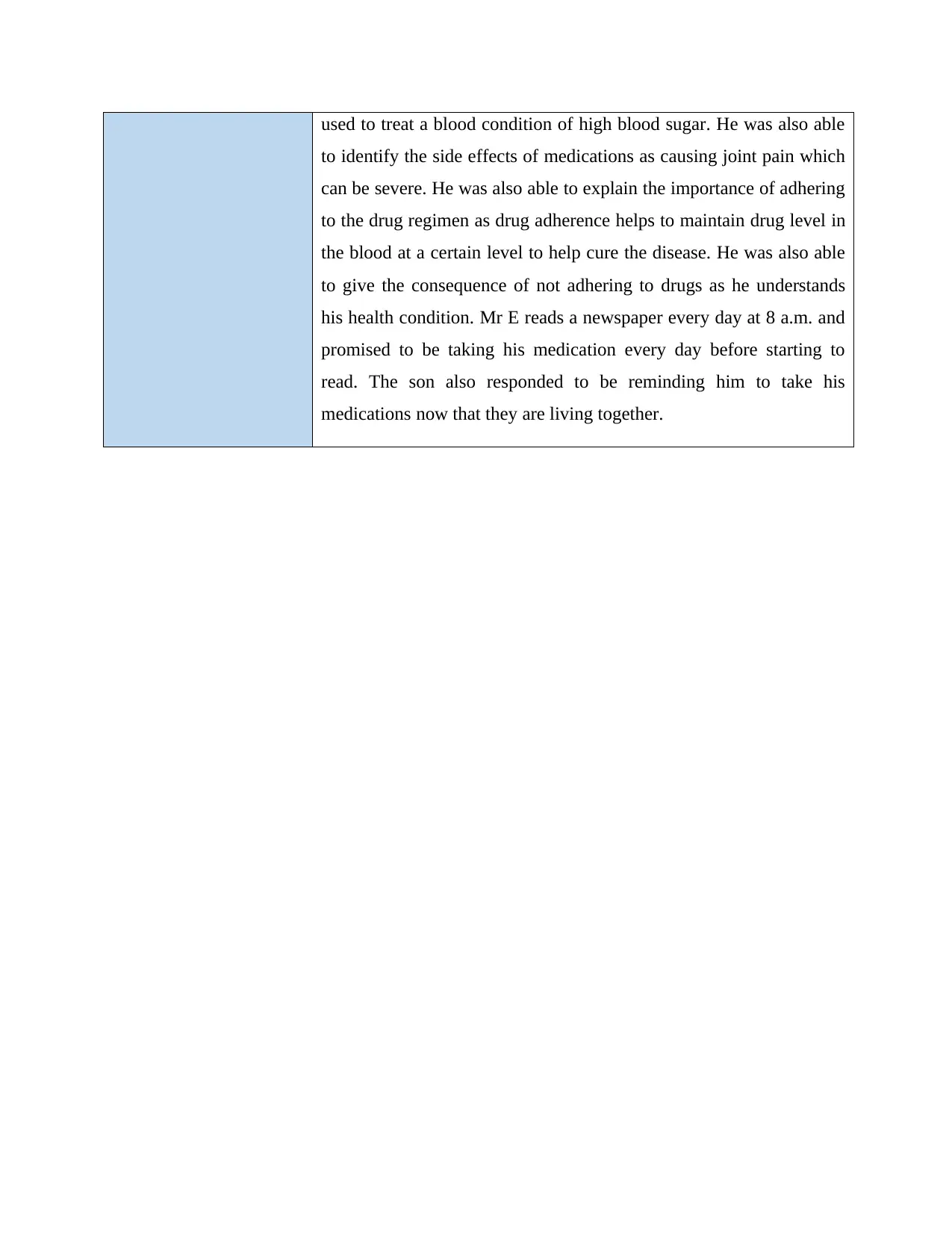
used to treat a blood condition of high blood sugar. He was also able
to identify the side effects of medications as causing joint pain which
can be severe. He was also able to explain the importance of adhering
to the drug regimen as drug adherence helps to maintain drug level in
the blood at a certain level to help cure the disease. He was also able
to give the consequence of not adhering to drugs as he understands
his health condition. Mr E reads a newspaper every day at 8 a.m. and
promised to be taking his medication every day before starting to
read. The son also responded to be reminding him to take his
medications now that they are living together.
to identify the side effects of medications as causing joint pain which
can be severe. He was also able to explain the importance of adhering
to the drug regimen as drug adherence helps to maintain drug level in
the blood at a certain level to help cure the disease. He was also able
to give the consequence of not adhering to drugs as he understands
his health condition. Mr E reads a newspaper every day at 8 a.m. and
promised to be taking his medication every day before starting to
read. The son also responded to be reminding him to take his
medications now that they are living together.
1 out of 7
Related Documents
Your All-in-One AI-Powered Toolkit for Academic Success.
+13062052269
info@desklib.com
Available 24*7 on WhatsApp / Email
![[object Object]](/_next/static/media/star-bottom.7253800d.svg)
Unlock your academic potential
Copyright © 2020–2025 A2Z Services. All Rights Reserved. Developed and managed by ZUCOL.





